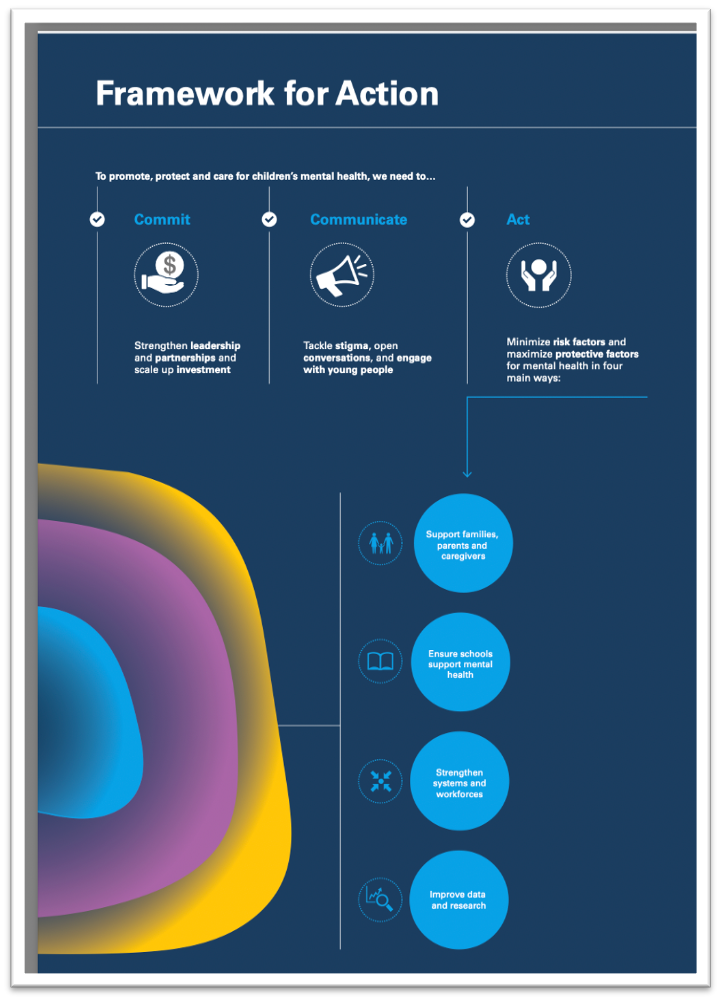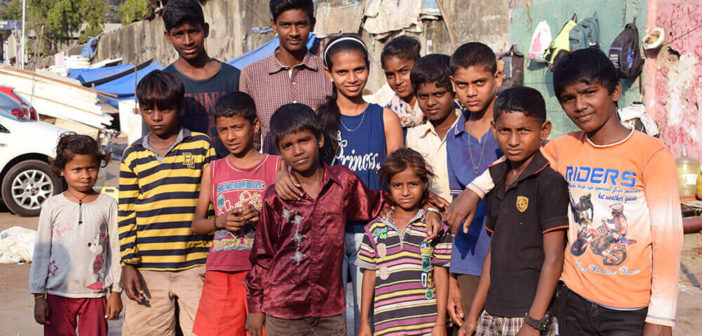UNICEF’s State of World’s Children (SOWC) for 2021 is focused on Mental Health of children. Among other things, the report notes that 13% (166 million) adolescents aged 10–19 live with a diagnosed mental disorder. The report also states that the cost of inaction could be hundreds of billion dollars. Here is a review.
The State of World’s Children (SOWC) is UNICEF’s flagship report that is published bi-annually. Since its first report in 1980-81, SOWC provides comprehensive information on the trends and issues affecting children across the globe. SOWC acts as a guide in shaping up UNICEF’s priorities and helps to calibrate and implement effective programmes for children across countries.
The latest edition i.e., SOWC-2021 explores one such key issue affecting children worldwide – Mental Health. This report published recently is titled ‘On My Mind: Promoting, protecting and caring for children’s mental health’.
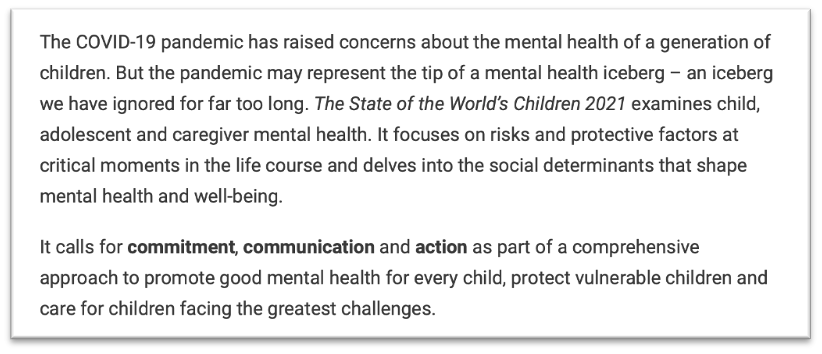
While SOWC – 2021 provides information on trends regarding the various parameters relating to Children’s wellness, we look specifically at the main theme i.e., the Mental Health of Children, in this story.
Estimates indicate that around 13% of adolescents in the world had a mental disorder
SOWC-2021 report states that Mental Health includes the human capacity to think, feel, learn, work, build meaningful relationships and contribute to communities and the world. It is an intrinsic part of individual health which has its bearing on building healthy communities.
The report stresses that Mental health is a right that must be promoted and protected. However, in many societies, Mental health mostly remains an afterthought for decision-makers in the family & society. The stigma & misunderstanding result in millions of children struggling in silence with mental health conditions including – depression, anxiety, conduct, and attention disorders, etc.
As per the estimates provided in SOWC-2021,
- 13% of the 1.2 billion adolescents (aged 10-19 years) around the world as of 2020, had a mental disorder.
- Of these, 80 million adolescents are between 10-14 years and around 86 million are between 15-19 years.
- Data indicates that adolescent boys are slightly more likely to experience mental disorders than girls in both these age groups.
- Boys in the adolescent age (10-19) years have a higher prevalence of mental disorders with 13.8% compared to girls, in whose case it is 12.5%
- However, a 2021 study conducted in 73 countries shows that girls are more likely to have mental health conditions which can be defined as psychological stress – a lack of life satisfaction or a sense of flourishing & happiness.
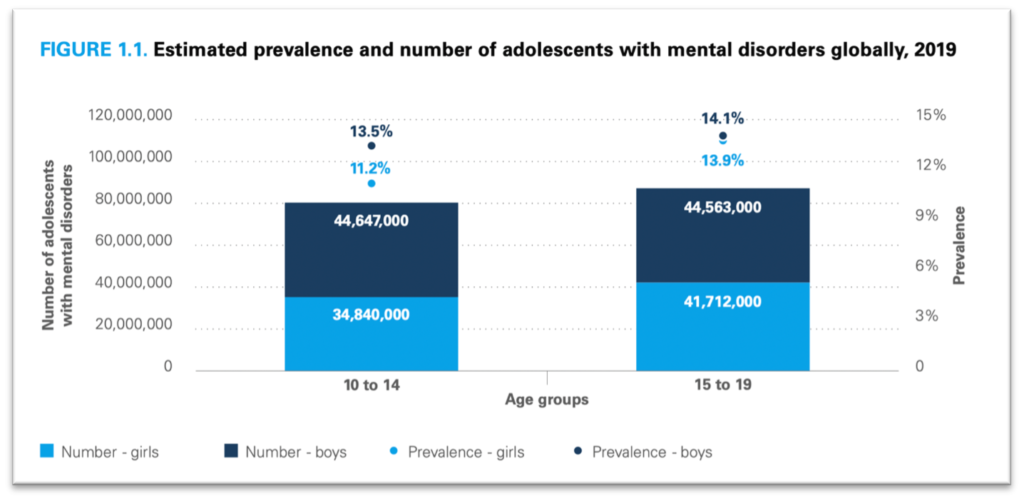
Among the geographical regions, ‘South Asia’ and ‘East Asia & Pacific’ had the highest number of adolescents with Mental disorders. However, in terms of prevalence rates – ‘Middle East & North Africa’, ‘North America’ and ‘Western Europe’ are ahead of the other regions.
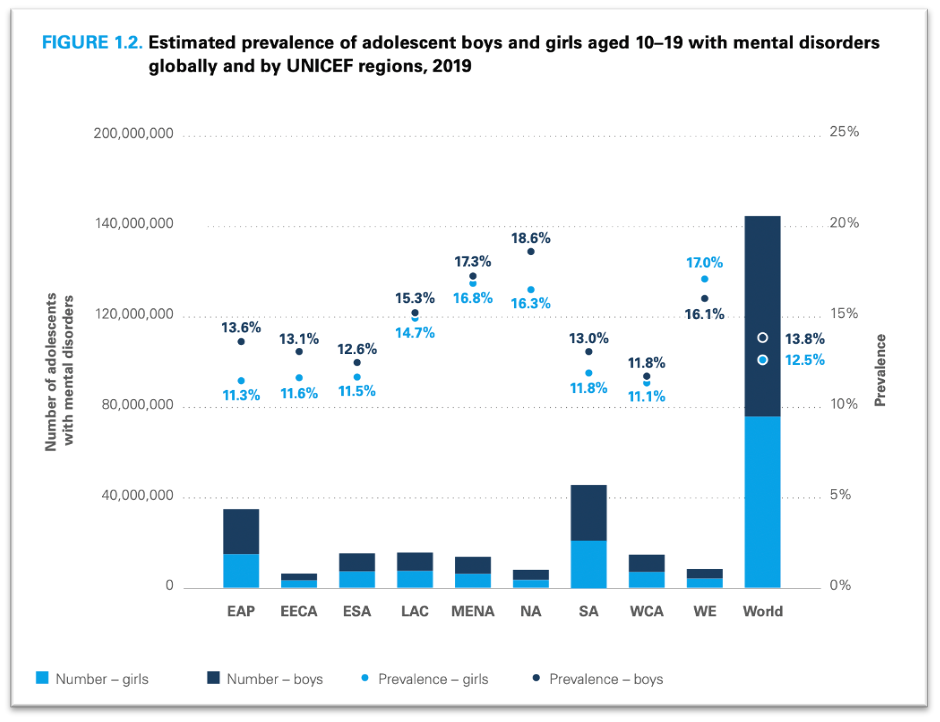
As per a survey conducted by UNICEF and Gallup in 21 countries, during the first half of 2021, around 1 in every 5 young people (aged 15-24) on average, i.e., 19% are reported to often feeling depressed or showing little interest in doing things. African countries of Cameroon and Mali recorded the highest with 32% & 31% of its young population feeling depressed. Among the Asian countries, Indonesia is at the top with 29%.
India is better off among these 21 countries with 14% of its young population reported having feeling depressed. It has the 7th lowest proportion of its young population feeling depressed, with Japan & Ethiopia reporting only 10%.
In view of the COVID-19 pandemic, these numbers provide an important insight into the state of Mental Health of children who were away from schools for a long period. However, the lack of any comparable data from an earlier period makes it a challenge to assess the impact of COVID-19.
Anxiety & Depression make up about 40% of Mental disorders among adolescents
The report states that among adolescents (10-19 years), anxiety & depression disorders make up around 40% of the mental disorders included in the ‘Global Burden of Disease’ study by the Institute of Health Metrics and Evaluation (IHME). The prevalence of anxiety and depressive disorders is higher in girls at 56.3% compared to that of boys where it is 31.4%. The other disorders include conduct disorders, attention deficit, intellectual disability, etc. Attention deficit, conduct disorder, etc. find a higher prevalence among the boys compared to that of girls.
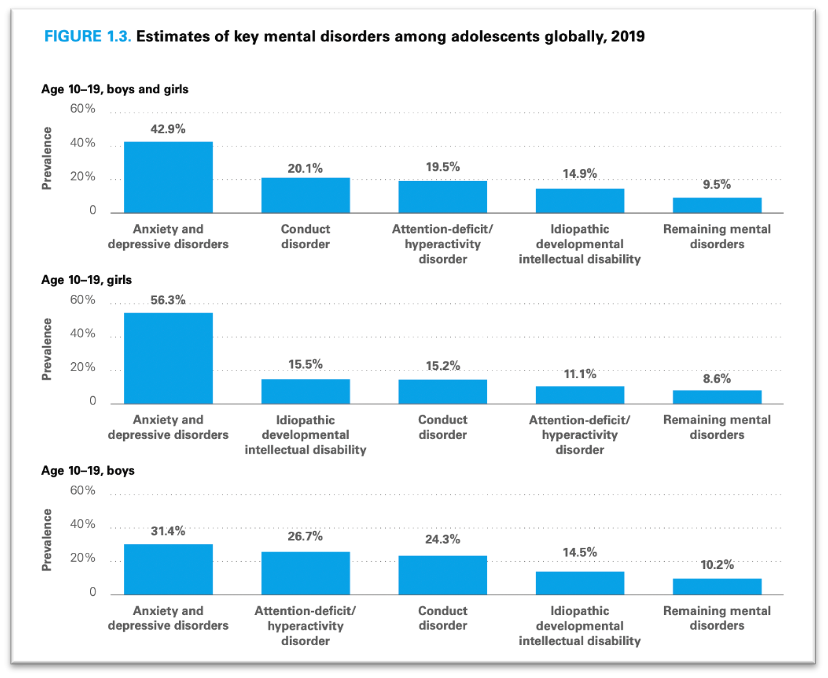
Meanwhile, as per the estimates of WHO (World Health Organization), around 45.8 thousand adolescents die of suicides every year. Among adolescents (10-19 years), it is the 5th most prevalent cause of death. It remains among the main causes of death across the different adolescent age groups for both genders.
Among the 15-19 age group, Suicide is the 4th main prevalent cause of death. In the case of girls, it is the 3rd main cause while in the case of boys, it is the 4th main cause of death in this age group. However, in terms of prevalence, more boys (6 per one lakh) die due to suicide every year compared to girls (5 per one lakh).
Suicide is a major cause of death among adolescents is prevalent across the geographies. It is the main cause of death in Eastern Europe and Central Asia. Whereas in North America, Western Europe, and South Asia, it is the second most prevalent cause of death.
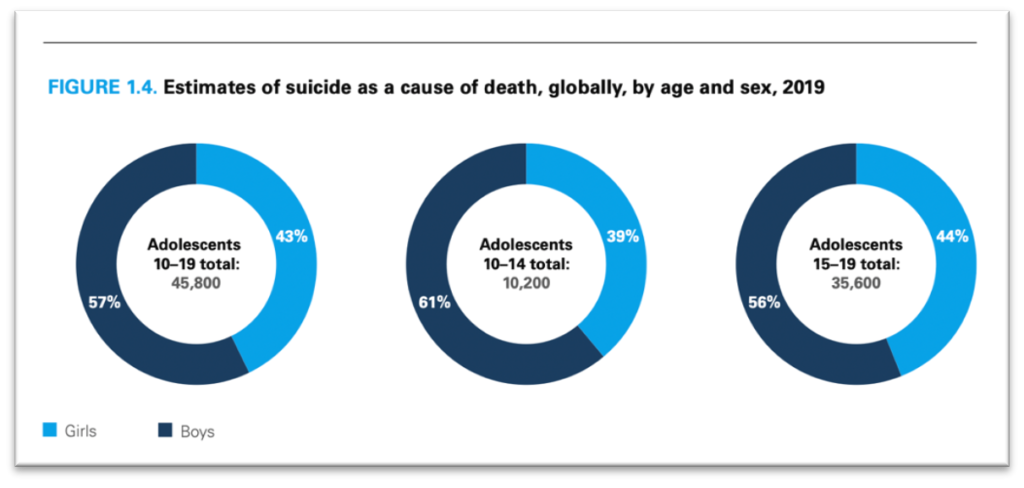
Annual loss in Human Capital due to Mental health conditions is around USD 340 billion
The SOWC-2021 states that the human cost of ignoring mental health can have a devastating effect on individuals, which further has an impact on families and communities. Apart from this, it could also have a financial impact i.e., the cost of inaction due to mental health conditions.
UNICEF has relied on ‘Department of Health Policy’ of ‘London School of Economics & Political Science’ to come up with a Global estimate of cost of Mental health conditions, specifically for SOWC-2021. The estimate was made on the premise – the value of lost mental capital which children and young people would contribute if they were not impacted by mental health conditions.
- As per the estimates, the loss of Human capital because of Mental health conditions is USD 340.2 billion, adjusted to PPP dollars.
- The condition with the highest cost is Anxiety (91.6 thousand million USD) followed by Childhood behavioural disorder and Depression.
- These three disorders make up to about 72% of the total cost to human capital due to mental health disorders.
It is further estimated that additionally around USD 47 billion is lost due to Intentional Self-harm. Therefore, the overall loss of Human capital is estimated to be around USD 387.2 billion (PPP).
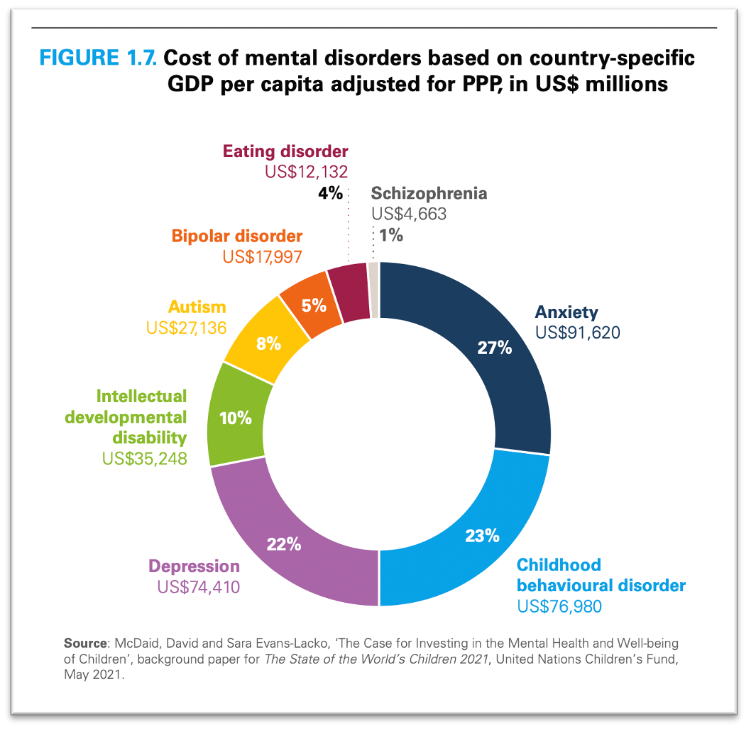
Among the various regions, East Asia & Pacific, North America, and Western Europe have the highest loss in terms of absolute value. However, this could be due to the higher productivity in these regions driving the value of Human capital lost. The value of loss in less developed countries could be lower. To correct this, a global average of USD 16,951 is taken as average income and adjusted to PPP terms. As per this estimate, the global loss of Human capital is USD 393.2 billion PPP. The loss due to Self-harm has increased to USD 57.7 billion, increasing in the overall loss of human potential to USD 451 billion per year.
Identifying the factors contributing to Mental Health disorders and developing a framework for Action
The report has at length discussed the contributing factors which could impact the Mental health of the children. These factors range from interactions with the surroundings to the impact of larger events. Three major Spheres of influence are identified:
- World of the Child
- World around the child
- World at Large
The first two spheres of influence have a cascading effect on the child as they grow. The World of the child includes – Parents and caregivers. Nutrition, stable & safe homes, engaged caregivers, caring & enriching environments, etc. are essential and have an impact on the mental health of the child.
As the child grows, the world around the child also grows – pre-schools, schools, communities, etc. It is imperative that each of these places provide safety and security for the child.
Other larger factors also have a bearing on the Mental health conditions as the child grows up. These include large-scale influencing factors like – poverty, disasters, conflicts, discrimination, migration, pandemics, etc.
As part of the larger factors influencing the mental health of a child, the report tries to ascertain the impact of the COVID-19 pandemic on the health of the children. The effects of pandemic including – loss of comfort & assurance of school routine, loss of parents & immediate kin, poverty & economic stress, vulnerability, etc., could have had a detrimental effect on the Mental health of children. The stress is observed more across economically vulnerable sections of society and across less developed countries. The lack of data pre-pandemic makes it a challenge to compare the impact of COVID-19 on the mental health of children.
SOWC-21 advocates for a commitment that is backed up by:
- Investment Commitment
- Communicate to break down the stigma and barriers to change
- Action to minimize the risk factors and maximize the protective factors, to promote and protect the mental health of every child.
